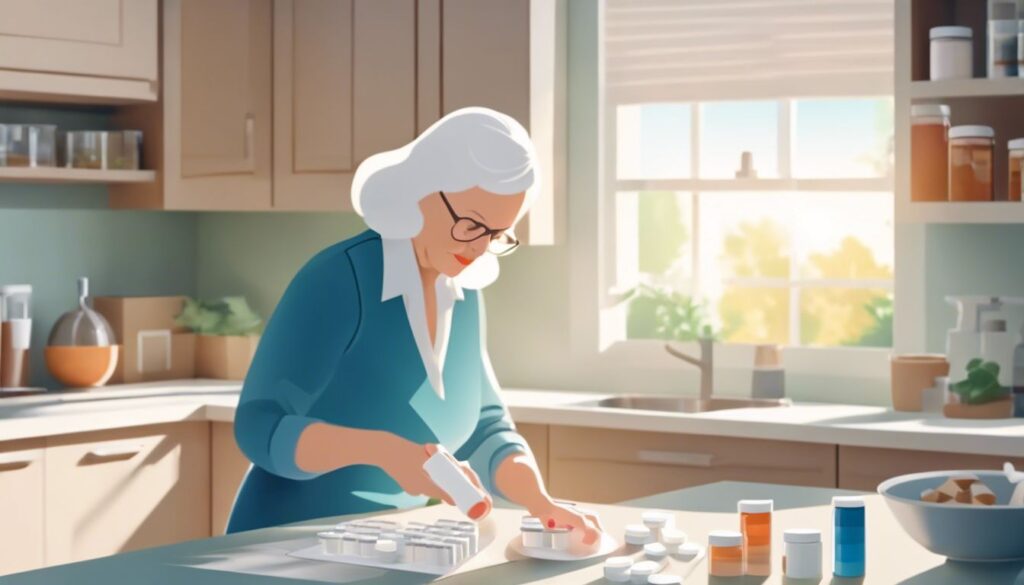Falls pose a serious risk to seniors, often leading to injuries and loss of independence. Each day, 74 older adults die from fall-related injuries in the United States. Proper medication management plays a crucial role in reducing fall risks for seniors.
This article explores effective strategies for medication review and adherence to enhance fall prevention. Learn how to keep your loved ones safe.
📋✅
- Medication management is vital for fall prevention in seniors, as 74 older adults die daily from fall-related injuries in the U.S.
- Regular medication reviews by healthcare providers help identify and adjust fall risk medications, such as psychotropic drugs.
- Educating seniors on proper medication use, including the importance of vitamin D and calcium for bone health, improves adherence and reduces fall risks.
- Comprehensive home safety assessments, including removing tripping hazards and installing handrails, work alongside medication management to prevent falls.
- Collaboration between doctors, pharmacists, and nurses ensures thorough medication evaluations and better fall prevention strategies for older adults.
Identifying Fall Risk Medications

Certain medications can increase fall risks in seniors. A thorough review of prescriptions helps identify and adjust these drugs to reduce dangers.
Reviewing and adjusting prescriptions to minimize risks
Reviewing and adjusting prescriptions is crucial for fall prevention in seniors. Healthcare providers should conduct regular medication reviews to identify and mitigate potential risks.
- Assess fall risk medications:
- Identify drugs that increase fall risk, such as psychotropic medications
- Evaluate the total psychoactive drug load on the patient
- Consider alternatives for high-risk medications when possible
- Implement medication changes:
- Taper or discontinue falls risk increasing drugs
- Replace high-risk medications with safer alternatives
- Adjust dosages to minimize side effects that contribute to falls
- Monitor medication effects:
- Track changes in balance, coordination, and cognition
- Assess for orthostatic hypotension and other side effects
- Evaluate the impact of medication changes on fall risk
- Collaborate with healthcare team:
- Involve pharmacists in identifying fall risk factors
- Consult with specialists for complex medication regimens
- Coordinate care between primary care providers and specialists
- Educate patients and caregivers:
- Explain the importance of medication adherence
- Discuss potential side effects and warning signs
- Provide clear instructions for taking medications safely
Enhancing Medication Adherence
Effective medication adherence strategies, like pill organizers and reminder apps, help seniors take their prescriptions correctly and on time. Read on to learn more about improving medication management for fall prevention.
Educating seniors on the importance of consistent medication intake
Educating seniors on consistent medication intake is crucial for fall prevention. Pharmacists play a key role in this process, offering accessible expertise on drug interactions and potential side effects.
Resident education programs focus on disease states and medication impacts, empowering seniors to recognize adverse reactions. These initiatives often include information on the importance of vitamin D and calcium for bone health.
Pharmacists are the most accessible healthcare professionals with intimate knowledge of medications.
Anemia assessment and correction can significantly reduce fall risks in older adults. Tailored education plans address individual health conditions and medication regimens. These programs emphasize the need for regular medication reviews and proper adherence to prescribed dosages.
Seniors learn to identify fall risk increasing drugs and understand the importance of discussing any concerns with their healthcare providers.
Collaborative Approaches
Healthcare providers play a key role in medication management. Regular reviews with doctors and pharmacists can spot potential issues and adjust treatments.
Involving healthcare providers in comprehensive medication reviews
Comprehensive medication reviews by healthcare providers play a crucial role in fall prevention for seniors. Pharmacists, considered the most accessible healthcare professionals, can address medication-related issues effectively.
- Collaborative approach: Engage physicians, nurses, and pharmacists to conduct thorough medication assessments.
- Regular reviews: Schedule quarterly medication evaluations to identify potential fall risks and make necessary adjustments.
- Medication reconciliation: Cross-check prescribed drugs against current health conditions to prevent adverse interactions.
- Fall risk assessment: Evaluate medications that may increase fall risks, such as antihypertensives or antidepressants.
- Dosage optimization: Adjust medication doses to minimize side effects while maintaining therapeutic benefits.
- Alternative therapies: Explore non-pharmacological options to reduce reliance on high-risk medications.
- Patient education: Provide clear instructions on proper medication use and potential side effects.
- Monitoring systems: Implement remote patient monitoring to track medication adherence and health status.
- Interdisciplinary communication: Establish protocols for seamless information sharing among healthcare providers.
- Medication management tools: Utilize pill organizers or electronic reminders to improve adherence and reduce errors.
Conducting a Comprehensive Home Safety Assessment to Reduce Fall Risks
Home safety assessments play a crucial role in fall prevention for seniors. A thorough evaluation identifies and addresses potential hazards, significantly reducing the risk of accidents.
- Remove tripping hazards: Clear walkways of cords, rugs, and clutter
- Install handrails: Add support on both sides of stairs and in bathrooms
- Improve lighting: Ensure bright, even illumination throughout the home
- Secure loose items: Fasten carpets and repair uneven flooring
- Organize frequently used items: Place them within easy reach
- Add non-slip mats: Place in showers, tubs, and on bathroom floors
- Adjust furniture layout: Create clear paths for easy navigation
- Check outdoor areas: Repair uneven walkways and add proper lighting
- Install grab bars: Place near toilets and in showers for added stability
- Use assistive devices: Provide walkers or canes as needed for mobility
Conclusion
Medication management stands as a cornerstone in fall prevention for seniors. Proper review and adjustment of prescriptions can significantly reduce fall risks. Educating older adults about their medications empowers them to take control of their health.
Collaboration between healthcare providers ensures comprehensive care and safer medication use. Implementing these strategies alongside home safety measures creates a robust defense against falls, promoting independence and well-being for seniors.
For more detailed information on ensuring your living space is as safe as possible, visit our guide on how to conduct a comprehensive home safety assessment to reduce fall risks.
FAQs
1. How do medications affect fall risk in seniors?
Certain drugs can cause dizziness, low blood pressure, or weakness. These side effects increase fall risk. Common culprits include blood pressure meds, antidepressants, and sedatives.
2. Which medications are most likely to cause falls?
Benzodiazepines, opioids, and antipsychotics pose high fall risks. Other risky meds include diuretics, antidiabetics, and some heart drugs. These can affect balance and mental clarity.
3. Can managing chronic conditions reduce fall risk?
Yes. Proper treatment of conditions like diabetes, hypertension, and dementia lowers fall risk. Good medication management is key for chronic illness control.
4. How does polypharmacy impact fall prevention?
Taking multiple medications increases side effect risks. It can lead to drug interactions and confusion. Seniors should review all meds with their doctor regularly.
5. What role do healthcare providers play in medication management for fall prevention?
Doctors and pharmacists can review meds, adjust dosages, and suggest alternatives. Physical therapists can address balance issues from medication side effects.
6. Are there non-drug options for fall prevention?
Yes. Exercise, home safety modifications, and vision checks help prevent falls. A personal emergency response system can also provide quick help if a fall occurs.









